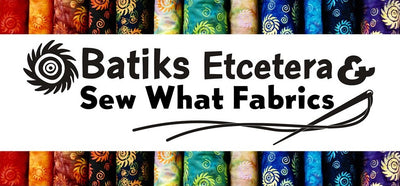How Batiks Are Made

Batik fabric: what is it, where does it come from and how do they really do that? This column will address basic questions about these gorgeous fabrics. First a definition straight from Merriam Webster: "batik (n): a fabric printed by an Indonesian method of hand-printing textiles by coating with wax the parts not to be dyed". Although there are many types of "resist" that can be used, wax is the most common. Beeswax, paraffin wax, and resins can be purchased already mixed, or custom mixed by the artist. The majority of batik fabrics available for purchase today are imported to the United States from Indonesia. Unlike commercial screen printed fabrics, batiks are still made by hand using the traditional wax and dye methods. These methods are as unique as the country in which they are produced.
Indonesia is a series of islands stretching along the equator from Malaysia to Australia. Two of the more populous and well known islands, Java and Bali, are where many batiks are produced. Bali is characterized by rich soils, abundant water and friendly people. The rich soil allowed early Balinese to have the time to pursue may art forms including carving of wood and stone, forging silver jewelry and of course the production of unique batik and ikat fabrics. It is on the island of Bali where the observations in this article were made.
There are numerous methods of applying the resist to the fabric. The three most common are:
- using a tjanting (pronounced chanting) tool for free hand drawing each and every line and dot in the design
- applying the wax to the fabric by hand using a metal tjap (pronounced chop)
- using a sponge or brush to apply the resist.
For production fabrics (a very loose term when applied to hand made fabrics), tjaps are the method of choice, simply because they are faster to use.
Once a design has been approved for production , a metal artist needs to make a tjap. A tjap is a series of copper plates arranged on a wooden handle in the desired design. Tjaps are used to carry the hot wax to the fabric. The hot wax surrounds the fibers in the fabric and resists the movement of dye into them. In other words, when the waxed fabric is submerged in to a dye bath, the fabric under the wax resists the dye, and stays the same color as it was before dyeing.
Sounds fairly simple, right? Well, many people prefer the multi color designs as opposed to the simple two-color design from one round of wax & dye, so the artists need to understand what will happen with the designs and colors when they repeat the process for subsequent dye baths. All production starts with griege (pronounced gray) goods. This is the term for basic, ready to dye fabric. To simplify the process of creating a complex batik design with many colors, the artists may use one or many techniques prior to the first application of wax. These dyeing techniques range from simple dyeing with a single color to hand painting the griege goods, to treating the fabric with sea salt or urea (a common fertilizer) to produce unique background patterns. After the initial dyeing, the fabric is carried by hand outside to dry in the tropical sun and trade winds of Bali. Once dry, it is hand carried back inside to receive an application of wax and the process continues.
If the tjap imprints are done carefully it is virtually impossible to see that each yard of fabric has 9 to 12 different sets of the imprint. More complex designs can easily have twice that number of imprints put on at two or three different times with dyeing, hand painting, and drying in between.
Considering the volume of fabric coming from Bali, many people think that it is produced with the help of machines. From what the author saw of the largest companies’ facility - they are not - the most complex machine on the property was a large wringer!
Hopefully this brief description of the batik process will give you a new appreciation for what goes in to making these beautiful hand made fabrics. Next time you are working with these fabrics, imagine the warm sun drying the fabric south of the equator.
Copyright Jan Smiley 1997

